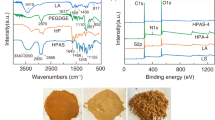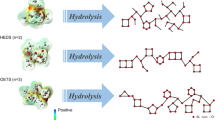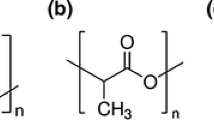Abstract
The effect of styrene-divinylbenzene copolymer functionalization by carboxylic acid groups on the adsorption of p-nitrophenol (p-NP) from aqueous solutions was investigated. The adsorption capacity of p-NP onto the functionalized copolymer (CP-F) was compared with that of the precursor copolymer, the chloromethylated styrene-divinylbenzene copolymer (CP-N). The two copolymers were characterized by Fourier transform infrared (FTIR) spectroscopy, thermal analysis (DSC-TG), specific surface area and particle size measurements, pore size distribution, scanning electron microscopy (SEM), and elemental analysis (EDX). The adsorption of p-NP was substantially enhanced after the polymer functionalization, and it was demonstrated that hydrogen bonding is principally responsible for the high adsorption capacity of CP-F in comparison with CP-N. The adsorption kinetics of p-NP adsorption onto CP-F was well described by the pseudo-second-order model. From the four investigated isotherms, Langmuir, Freundlich, Redlich-Peterson, and Sips, the equilibrium data were better described by the Sips model. The maximum adsorption capacity of the CP-F polymer resulting from the Sips isotherm was 243.37 mg g−1. The capacity of regeneration and reuse of the CP-F polymer was evaluated in three consecutive cycles of adsorption-desorption.
















Similar content being viewed by others
References
Ahmaruzzaman, M., & Gayatri, S. L. (2010). Activated tea waste as a potential low-cost adsorbent for the removal of p-nitrophenol from wastewater. Journal of Chemical Engineering Data, 55, 4614–4623.
Ahmed, S., Rasul, M. G., Martens, W. N., Brown, R., & Hashib, M. A. (2011). Advances in heterogeneous photocatalytic degradation of phenols and dyes in wastewater: a review. Water Air and Soil Pollution, 215, 3–29.
An, F., Du, R., Wang, X., Wan, M., Dai, X., & Gao, J. (2012). Adsorption of phenolic compounds from aqueous solution using salicylic acid type adsorbent. Journal of Hazardous Materials, 201-202, 74–81.
Bastami, T. R., & Entezari, M. H. (2012). Activated carbon from carrot dross combined with magnetite nanoparticles for the efficient removal of p-nitrophenol from aqueous solution. Chemical Engineering Journal, 210, 510–519.
Busca, G., Berardinelli, S., Resini, C., & Arrighi, L. (2008). Technologies for the removal of phenol from fluid streams: a short review of recent developments. Journal of Hazardous Materials, 160, 265–288.
Dabrowski, A., Podkościelny, P., Hubicki, Z., & Barczak, M. (2005). Adsorption of phenolic compounds by activated carbon—a critical review. Chemosphere, 58, 1049–1070.
EEC Directive 80/778/EEC 15-7-1990: Official Journal of the European Communities (1990) 30–8-1990, European Community, Brussels.
Erdem, M., Yüksel, E., Tay, T., Çimen, Y., & Türk, H. (2009). Synthesis of novel methacrylate based adsorbents and their sorptive properties towards p-nitrophenol from aqueous solutions. Journal of Colloid and Interface Science, 333, 40–48.
Fan, C. M., Zhang, L. F., Wang, S. S., Wang, D. H., Lu, L. Q., & Xu, A. W. (2012). Novel CeO2 yolk-shell structures loaded with tiny Au nanoparticles for superior catalytic reduction of p-nitrophenol. Nanoscale, 4, 6835–6840.
Gimeno, O., Carbajo, M., Beltrán, F. J., & Rivas, F. J. (2005). Phenol and substituted phenols AOPs remediation. Journal of Hazardous Materials, B119, 99–108.
Hamdaoui, O., & Naffrechoux, E. (2007a). Modeling of adsorption isotherms of phenol and chlorophenols onto granular activated carbon part I. Two-parameter models and equations allowing determination of thermodynamic parameters. Journal of Hazardous Materials, 147, 381–394.
Hamdaoui, O., & Naffrechoux, E. (2007b). Modeling of adsorption isotherms of phenol and chlorophenols onto granular activated carbon part II. Models with more than two parameters. Journal of Hazardous Materials, 147, 401–411.
Ho, Y. S., & McKay, G. (1999). Pseudo-second order model for sorption processes. Process Biochemistry, 34, 451–465.
Honfi, K., Tálos, K., Kőnig-Péter, A., Kilár, P., & Pernyeszi, T. (2016). Copper(II) and phenol adsorption by cell surface treated Candida tropicalis cells in aqueous suspension. Water Air and Soil Pollution, 227, 61.
Huang, J., Huang, K., Liu, S., Luo, Q., & Shi, S. (2008). Synthesis, characterization, and adsorption behavior of aniline modified polystyrene resin for phenol in hexane and in aqueous solution. Journal of Colloid and Interface Science, 317, 434–441.
Huang, J., Yan, C., & Huang, K. (2009). Removal of p-nitrophenol by a water-compatible hypercrosslinked resin functionalized with formaldehyde carbonyl groups and XAD-4 in aqueous solution: a comparative study. Journal of Colloid and Interface Science, 332, 60–64.
Jaerger, S., dos Santos, A., Fernandes, A. N., & Almeida, C. A. P. (2015). Removal of p-nitrophenol from aqueous solution using Brazilian peat: kinetic and thermodynamic studies. Water Air and Soil Pollution, 226, 236.
Koyuncu, H., Yildiz, N., Salgin, U., Köroğlu, F., & Çalimli, A. (2011). Adsorption of o-, m- and p-nitrophenols onto organically modified bentonites. Journal of Hazardous Materials, 185, 1332–1339.
Ksibi, M., Zemzemi, A., & Boukchina, R. (2003). Photocatalytic degradability of substituted phenols over UV irradiated TiO2. Journal of Photochemistry and Photobiology A, 159, 61–70.
Kulkarni, M., & Chaudhari, A. (2006). Biodegradation of p-nitrophenol by P. putida. Bioresource Technology, 97, 982–988.
Li, A., Zhang, Q., Chen, J., Fei, Z., Long, C., & Li, W. (2001). Adsorption of phenolic compounds on Amberlite XAD-4 and its acetylated derivative MX-4. Reactive and Functional Polymers, 49, 225–233.
Li, A., Zhang, Q., Zhang, G., Chen, J., Fei, Z., & Liu, F. (2002). Adsorption of phenolic compounds from aqueous solutions by a water-compatible hypercrosslinked polymeric adsorbent. Chemosphere, 47, 981–989.
Lin, S. H., & Juang, R. S. (2009). Adsorption of phenol and its derivatives from water using synthetic resins and low-cost natural adsorbents: a review. Journal of Environmental Management, 90, 1336–1349.
Liu, B., Yang, F., Zou, Y., & Peng, Y. (2014). Adsorption of phenol and p-nitrophenol from aqueous solutions on metal–organic frameworks: effect of hydrogen bonding. Journal of Chemical &Engineering Data, 59, 1476–1482.
Lorenc-Grabowska, E., & Gryglewicz, G. (2007). Adsorption characteristics of Congo Red on coal-based mesoporous activated carbon. Dyes and Pigments, 74, 34–40.
Ma, Y., Zhou, Q., Li, A., Shuang, C., Shi, Q., & Zhang, M. (2014). Preparation of a novel magnetic microporous adsorbent and its adsorption behavior of p-nitrophenol and chlorotetracycline. Journal of Hazardous Materials, 266, 84–93.
Moreno-Castilla, C. (2004). Adsorption of organic molecules from aqueous solutions on carbon materials. Carbon, 42, 83–94.
Nakanishi K, & Solomon P.H (1997). Infrared absorption spectroscopy. Second ed., Holden-Day, Inc.
Nakatsuji, Y., Salehi, Z., & Kawase, Y. (2015). Mechanisms for removal of p-nitrophenol from aqueous solution using zero-valent iron. Journal of Environmental Management, 152, 83–191.
Ngah, W. S. W., & Fatinathan, S. (2006). Chitosan flakes and chitosan-GLA beads for adsorption of p-nitrophenol in aqueous solution. Colloids and Surfaces A, 277, 214–222.
Oller, I., Malato, S., & Sánchez-Pérez, J. A. (2011). Combination of advanced oxidation processes and biological treatments for wastewater decontamination—a review. Science of the Total Environment, 409, 4141–4166.
Păcurariu, C., Mihoc, G., Popa, A., Muntean, S. G., & Ianoş, R. (2013). Adsorption of phenol and p-chlorophenol from aqueous solutions on poly (styrene-co-divinylbenzene) functionalized materials. Chemical Engineering Journal, 222, 218–227.
Pan, B., Chen, X., Pan, B., Zhang, W., Zhang, X., & Zhang, Q. (2006). Preparation of an aminatedmacroreticular resin adsorbent and its adsorption of p-nitrophenol from water. Journal of Hazardous Materials, B137, 1236–1240.
Pan, B., Pan, B., Zhang, W., Lv, L., Zhang, Q., & Zheng, S. (2009). Development of polymeric and polymeric-based hybrid adsorbents for pollutants removal from waters. Chemical Engineering Journal, 151, 19–29.
Payne, G. F., & Maity, N. (1992). Solute adsorption from water onto a “modified” sorbent in which the hydrogen binding site is protected from water. Thermodynamics and separations. Industrial and Engineering Chemistry Research, 31, 2024–2033.
Peretti, S. W., Tompkins, C. J., Goodall, J. L., & Michaels, A. S. (2002). Extraction of 4-nitrophenol from 1-octanol into aqueous solution in a hollow fiber liquid contactor. Journal of Membrane Science, 195, 193–202.
Qiu, L., Peng, Y., Liu, B., Lin, B., Peng, Y., Malik, M. J., & Yan, F. (2012). Polypyrrole nanotube-supported gold nanoparticles: an efficient electrocatalyst for oxygen reduction and catalytic reduction of 4-nitrophenol. Applied Catalysis A:General, 413-414, 230–237.
Rodríguez, I., Llompart, M. P., & Cela, R. (2000). Solid-phase extraction of phenols. Journal ofChromatograpfyA, 885, 291–304.
Serjeant E.P & Dempsey B. (1979). Ionisation constants of organic acids in aqueous solution. International Union of Pure and Applied Chemistry (IUPAC). IUPAC Chemical Data Series No. 23, Pergamon Press, NY
Shah, B., Tailor, R., & Shah, A. (2012). Zeolitic bagasse fly ash as a low-cost sorbent for the sequestration of p-nitrophenol: equilibrium, kinetics, and column studies. Environmental Science and Pollution Research, 19, 1171–1186.
Sprynskyy, M., Ligor, T., Lebedynets, M., & Buszewski, B. (2009). Kinetic and equilibrium studies of phenol adsorption by natural and modified forms of the clinoptilolite. Journal of Hazardous Materials, 169, 847–854.
Sun, Y., Zhoua, J., Cai, W., Zhao, R., & Yuan, J. (2015). Hierarchically porous NiAl-LDH nanoparticles as highly efficientadsorbent for p-nitrophenol from water. Applied Surface Science, 349, 897–903.
Tang, D., Zheng, Z., Lin, K., Luan, J., & Zhang, J. (2007). Adsorption of p-nitrophenol from aqueous solutions onto activated carbon fiber. Journal of Hazardous Materials, 143, 49–56.
Tseng, R. L., Wu, F. C., & Juang, R. S. (2010). Characteristics and applications of the Lagergren’s first-order equation for adsorption kinetics. Journal of the Taiwan Institute of Chemical Engineers, 41, 661–669.
US EPA. (1987). Federal Register Washington, DC. 52(131), 25861–25962.
Weber, W. J., & Morris, J. (1963). Kinetics of adsorption on carbon from solution. Journal of the Sanitary Engineering Division, 89, 31–60.
Wu, F. C., Tseng, R. L., & Juang, R. S. (2009). Characteristics of Elovich equation used for the analysis of adsorption kinetics in dye-chitosan systems. Chemical Engineering Journal, 150, 366–373.
Xue, G., Gao, M., Gu, Z., Luo, Z., & Hu, Z. (2013). The removal of p-nitrophenol from aqueous solutions by adsorption using gemini surfactants modified montmorillonites. Chemical Engineering Journal, 218, 223–231.
Yavuz, E., Tekin, E. T., Kandaz, M., & Senkal, B. F. (2011). Preparation of dicarboxylic acid containing sulfonamide based resin and removal of basic dyes. Separation Science and Technology, 45(5), 687–691.
Zeng, X., Fan, Y., Wu, G., Wang, C., & Shi, R. (2009). Enhanced adsorption of phenol from water by a novel polar post-crosslinked polymeric adsorbent. Journal of Hazardous Materials, 169, 1022–1028.
Zolfaghari, G. (2016). β-Cyclodextrin incorporated nanoporous carbon: host–guest inclusion for removal of p-Nitrophenol and pesticides from aqueous solutions. Chemical Engineering Journal, 283, 1424–1434.
Acknowledgments
This work was supported by a grant of the Romanian National Authority for Scientific Research and Innovation, CNCS – UEFISCDI, project number PN-II-RU-TE-2014-4-0514.
Author information
Authors and Affiliations
Corresponding author
Rights and permissions
About this article
Cite this article
Istratie, R., Băbuţă, R., Popa, A. et al. Enhanced Adsorption of p-Nitrophenol from Aqueous Solutions Using a Functionalized Styrene-Divinylbenzene Copolymer. Water Air Soil Pollut 228, 276 (2017). https://doi.org/10.1007/s11270-017-3463-9
Received:
Accepted:
Published:
DOI: https://doi.org/10.1007/s11270-017-3463-9




